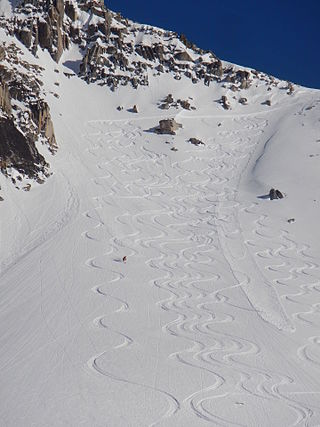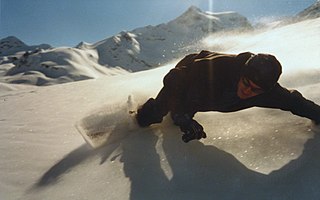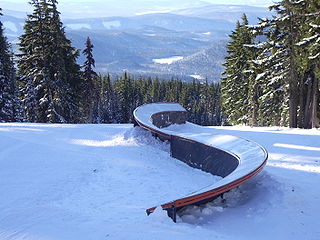
Snowboards are boards where the user places both feet, usually secured, to the same board. The board itself is wider than most skis, with the ability to glide on snow. Snowboards widths are between 6 and 12 inches or 15 to 30 centimeters. Snowboards are differentiated from monoskis by the stance of the user. In monoskiing, the user stands with feet inline with direction of travel, whereas in snowboarding, users stand with feet transverse to the longitude of the board. Users of such equipment may be referred to as snowboarders. Commercial snowboards generally require extra equipment, such as bindings and special boots which help secure both feet of a snowboarder, who generally ride in an upright position. These types of boards are commonly used by people at ski hills, mountains, backcountry, or resorts for leisure, entertainment, and competitive purposes in the activity called snowboarding.

Skiing is the use of skis to glide on snow for basic transport, a recreational activity, or a competitive winter sport. Many types of competitive skiing events are recognized by the International Olympic Committee (IOC), and the International Ski and Snowboard Federation (FIS).
Skis are runners, attached to the user's feet, designed to glide over snow. Typically employed in pairs, skis are attached to ski boots with ski bindings, with either a free, lockable, or partially secured heel. For climbing slopes, ski skins can be affixed to the base of each ski to prevent them from sliding backwards. Originally used as a means of travel over snow, skis have become specialized for recreational and competitive alpine and cross-country skiing.

Snowboarding is a recreational and competitive activity that involves descending a snow-covered surface while standing on a snowboard that is almost always attached to a rider's feet. It features in the Winter Olympic Games and Winter Paralympic Games.
Boardsports are active outdoor sports that are played with any sort of board as the primary equipment. These sports take place on a variety of terrains, from paved flat-ground and snow-covered hills to water and air. Most boardsports are considered action sports or extreme sports, and thus often appeal to youth. Some board sports were marginalized in the past. However, many board sports are gaining mainstream recognition, and with this recognition, they have gotten wider broadcasting, sponsorship and inclusion in institutional sporting events, including the Olympic Games.

Telemark skiing is a skiing technique that combines elements of Alpine and Nordic skiing, using the rear foot to keep balance while pushing on the front foot to create a carving turn on downhill skis with toe-only bindings. Telemark skiing is named after the Telemark region of Norway, where the discipline originated. Sondre Norheim is often credited for first demonstrating the turn in ski races, which included cross country, slalom, and jumping, in Norway around 1868. Sondre Norheim also experimented with ski and binding design, introducing side cuts to skis and heel bindings.

Backcountry skiing (US), also called off-piste (Europe), alpine touring, freeriding or out-of-area, is skiing in the backcountry on unmarked or unpatrolled areas either inside or outside a ski resort's boundaries. This contrasts with alpine skiing, which is typically done on groomed trails benefiting from a ski patrol. Unlike ski touring, backcountry skiing can – and often does – include the use of ski lifts including snowcats and helicopters. Recent improvements in equipment have increased the popularity of the sport. As the sport does confront the individual practicing it with the dangers of natural, unprepared alpine terrain like avalanches, it is generally recommended to carry standard safety equipment and to learn beforehand how to behave safely under such conditions.
Terje Håkonsen is a Norwegian professional snowboarder. He is considered one of the most influential snowboarders in the history of the sport. In the book The way of the snowboarder, Rob Reed wrote that "Haakonsen took the young sport of snowboarding and revolutionized nearly every aspect of it".

A snowskate is a snow sliding device which can be described as a hybrid of a snowboard, and a skateboard. Unlike a snowboard which uses bindings to secure the board to a riders feet, a snowskate is typically bindingless. The lack of bindings allows the rider to perform more skateboard-like flip tricks on the snow as opposed to what can be done on a traditional snowboard. Although the bindingless nature of the snowskate allows for the aforementioned skateboard-like tricks, snowskates can also be ridden in a style similar to traditional snowboarding, but with the added challenge and freedom of riding and carving bindingless. There are many types of snowskates depending on the brand and styling of riding, but the most common are single deck and bi-level snowskates.

Freeriding is a style of skiing or snowboarding performed on natural, un-groomed terrain, without a set course, goals or rules. It evolved throughout the sport's formative years as a contrary response to the highly regimented style of ski competition prevalent at the time. Snowboarders primarily refer to freeriding as backcountry, sidecountry, or off-piste snowboarding, and sometimes big mountain or extreme riding.
Burton Snowboards is a privately-owned snowboard manufacturing company that was founded by Jake Burton Carpenter in 1977. The company specializes in products aimed at snowboarders, such as snowboards, bindings, boots, outerwear, and accessories. The company, whose flagship store is in Burlington, Vermont, was privately owned by Jake Burton Carpenter, until his death in 2019, and by his wife, Donna Carpenter, who has been active in the business since 1983.

Ski geometry is the shape of the ski. Described in the direction of travel, the front of the ski, typically pointed or rounded, is the tip, the middle is the waist and the rear is the tail. Skis have four aspects that define their basic performance: length, width, sidecut and camber. Skis also differ in more minor ways to address certain niche roles. For instance, skis for moguls are much softer to absorb shocks from the quick and sharp turns of the moguls and skis for powder are much wider to provide more "float" in deeper, softer snow.

June Mountain ski area is a winter resort in the eastern Sierra Nevada of California, located near June Lake, southeast of Yosemite National Park.

Developed during the winter of 1996 by Martin and Erik Fey, the Teleboard consists of a long, narrow snowboard, or wide ski, with two free-heel telemark bindings arranged one in front of the other at a slight angle to the longitudinal axis. This is similar to a skwal which uses fixed-heel bindings mounted in line with each other.
Jeremy Jones is an American professional snowboarder and businessman who is the founder of Jones Snowboards. In addition to creating and improving his line of snowboards, Jones works to create films that record his climbing and snowboarding adventures around the world. In November 2012, Jones was selected by National Geographic as a nominee for Adventurer of the Year, based on his "remarkable achievements in exploration, conservation, humanitarianism, and adventure sports." Jones is also the founder of the non-profit group Protect Our Winters, which works to reduce the effects of global climate change by means of educational, activist and community-based projects. He is sponsored by: O'Neill, POC, CLIF Bar, Scott, Giro, 661 and Blue Bird Wax.

Backcountry snowboarding is snowboarding in a sparsely inhabited rural region over ungroomed and unmarked slopes or pistes in the backcountry, frequently amongst trees, usually in pursuit of fresh fallen snow, known as powder. Often, the land and the snow pack are not monitored, patrolled, or maintained. Fixed mechanical means of ascent such as ski lifts are typically not present, but alternative means such as splitboarding, hiking, snowshoeing and helicopters ("heliskiing") are sometimes used to reach the mountain's peak.

The following outline is provided as an overview of and topical guide to skiing:
4FRNT Skis is an independent brand of alpine ski equipment that helped to pioneer the development of the freeskiing movement. 4FRNT introduced the model of a skier-owned and operated ski company to the sport.
This glossary of skiing and snowboarding terms is a list of definitions of terms and jargon used in skiing, snowboarding, and related winter sports.

Jones Snowboards is a snowboard, snowboard binding, and snowboarding clothing & accessories manufacturer based near Lake Tahoe. The company was founded by renowned freeride snowboarder Jeremy Jones. The company has received numerous awards for its snowboards. Jones snowboards are manufactured in Dubai.















